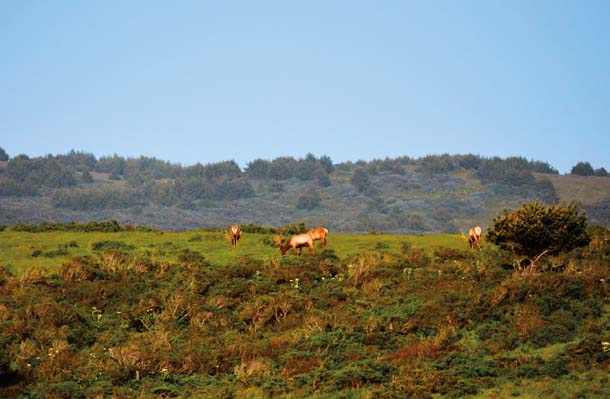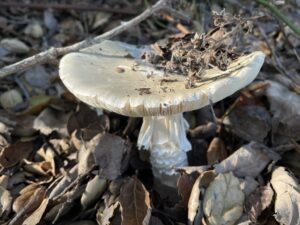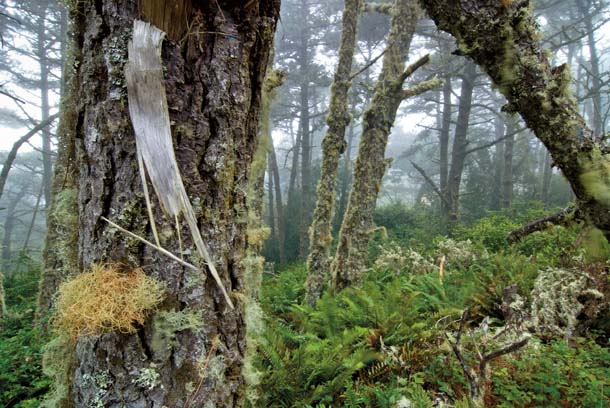The shrublands of the Point Reyes National Seashore, which include the northern coastal scrub and maritime chaparral, hooked me long ago with their vibrant charms. Found on slopes within the influence of the sea, they hug the land as tightly as a knitted sweater, shrugging off the challenges of wind, salt spray, and fog.
Northern coastal scrub is the shorter of the two, under eight feet, with a hardy palette of coyote bush, California sagebrush, sticky monkeyflower, lizardtail, poison oak, and others. Maritime chaparral sometimes, but not always, succeeds coastal scrub, with its assemblage of taller species such as coffeeberry, blueblossom ceanothus, silk tassel, toyon, and Pacific wax myrtle.
A broad sweep of coastal scrub or chaparral across a hillside is a uniquely Californian landscape, one in which a particular set of insects and birds rejoice. Over 200 species of insects frequent coyote bush, for instance. Quail hide, nest, and loaf in the shrublands. For deer and elk, they provide important browse. The wrentit, the most sedentary bird species in North America, spends its whole life in coastal scrub, ranging only 400 meters from home.
Sometimes referred to dismissively as “brush” or “scrub,” shrublands can seem an underappreciated landscape. Yet a tour of the shrublands of the Point Reyes National Seashore may leave you smitten with delight by the silken feel of California sagebrush’s fragrant gray-green leaves or the huge, pure white flower umbels of the tropical-looking cow parsnip surging sturdily out of the ground.
One soon learns that it is difficult to generalize about shrublands. Because of the many combinations of species, one of my most frequent reactions while exploring them is, “What, you here?” The Manual of California Vegetation deals with the variability this way: “The coastal scrub . . . is better thought of as a ‘collection of series,’ ” a series being a repeated grouping of species, with one or several dominating. Some of these different series will become evident as we journey through the Seashore on our “shrubland tour.” Circumstances being as varied as they are at Point Reyes, I have learned never to be surprised to be surprised.
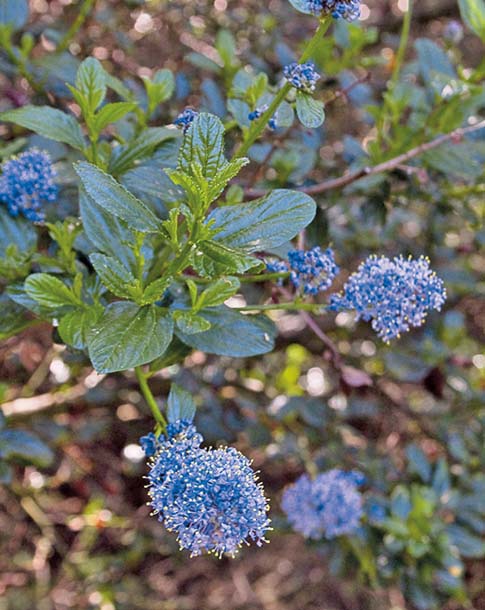
Expect to see a good deal of coyote bush (Baccharis pilularis), which is the pervasive “dominant” species in northern coastal scrub at Point Reyes. Coyote bush can be a generous companion, leaving room for bunchgrass circles and places at the edge of the path for annual and perennial wildflowers like yerba buena, angelica, baby white eyes, paintbrush, and ruby chalice clarkia. Or it can be a space hog.
The character it assumes, and indeed the character and makeup of shrubland in general, is the result of the particular land-use history of the site it inhabits, as well as the site’s intrinsic attributes, which include the direction it faces, the steepness of the slope, the underlying geology, the soil type, the intensity and direction of wind, its fire history, and the proximity of other vegetation types. On windswept, grazed coastal pastures at Bull Point, coyote bush grows only 15 inches high, with tiny leaves; its companion, the shrub lupine, is similarly dwarfed. The shrublands help us understand the specific consequences of the unique characteristics of each site.
Let’s begin our tour on the Ridge Trail near Palomarin. This steep trail transitions back and forth from scrub to chaparral. Coyote bush on the south (scrub) side of the trail has an unexpected understory of sticky monkeyflower; the delicate, diminutive gold-back fern; Torrey’s melic grass; and coral-colored Indian paintbrush. On the north (chaparral) side is coffeeberry, along with elderberry, blueblossom, and blue bush lupine. Where the trail flattens, I discovered a new-to-me component to the coastal scrub nestled into the coyote bush: Oregon grape, with large yellow blossoms followed by showy blue berries in summer.
Toward the middle of the park, Muddy Hollow shows us coyote bush dotted with cow parsnip, in full bloom in April. Other coastal scrub species–bracken fern, cucumber vine, sticky monkeyflower, native blackberry, and one lone coffeeberry–mingle with groupings of alders, elderberries, thimbleberry, and salmonberry, indicating the presence of moisture.
Let’s head north to Mount Vision for a case study of how the specifics of the Vision Fire 17 years ago led to an unusual shrubland succession. One dominant shrub of the maritime chaparral here is the elegant evergreen huckleberry, a plant lovely in all seasons. Its pink bell-like flowers are set off by shiny green leaves that when young are almost coral. Small blue-black berries follow, to the joy of many. It is good friends with salal, also with bell-like pink flowers, but possessing larger, dark-blue fruit, not quite as highly valued. One of the largest native bunchgrasses is found here too: Pacific reed grass, growing four feet tall and equally broad.

Fire frequently causes plants to transition from a woody series (such as coastal scrub) to an herbaceous series (such as coastal prairie). Yet during the Vision Fire, this steep slope burned hot enough to stimulate the germination of the fire-adapted seeds of blueblossom ceanothus. The result is a conversion from the shorter coastal scrub to the taller blueblossom-dominated chaparral. Alison Forrestel, former fire ecologist for the Seashore, says that ten years after the fire, blueblosssom had increased in area by more than 4,000 percent.
One consequence of this shift is an intoxicating honey-sweet fragrance filling the air in spring, accompanied by a loud bee drone directed at those same blue blossoms, and the presence of larger-than-usual numbers of the strikingly-patterned ceanothus moth, whose larval (caterpillar) stage feeds on ceanothus leaves.
Farther north, we head to the Estero Trail. From the parking lot, we see coyote bush, its green tips backlit down the hill in staggered arcs. Crossing the bridge over an inlet of Home Bay, we are rewarded by an exuberant mixture on the bluff, an unexpected combination of chaparral, scrub, woodland, and prairie species, which causes me to put an exclamation after each entry in my notes. Huckleberry! Hazel! Pacific wax myrtle! Willows follow small drainages down the slope. Cow parsnip edges the trail.
Pacific wax myrtle, which can grow to 60 feet tall in protected places in the Seashore, here assumes the same height as its neighbors, about five feet. When I think of where I’ve seen these plants before, and how different they looked, my notion of them and their life histories is expanded. This sense of mental expansion is one of the joys of a shrubland tour.
For contrast, let’s head back to the unburned southern end of the Seashore to visit PRBO Conservation Science’s Palomarin Field Station. In the late ’70s the ornithologists here began their long-term studies of the birds attracted to coastal scrub, creating a detailed and invaluable record of births, deaths, marriages, and divorces. Every spring, Tom Gardali, an ecologist at PRBO, tells new interns the story of human land use around the field station.
It begins with the fires set by the Coast Miwok, with varied and sophisticated intentions, such as maintaining browse for game animals or grassland for their seed harvests. Their tenure was followed by the agricultural endeavors of The Church of the Golden Rule, whose adherents farmed these marine terraces for many years. When they left in 1965, the farmed land (re)turned quickly into coastal scrub.
In the late 90s, the tall and vigorous native conifer Douglas fir moved into the area, shading out and radically changing the coastal scrub study areas. The decision not to intervene seemed consistent with the goals of researchers at a scientific organization–to let nature, in the form of natural succession, take its course. Yet as Gardali puts it, “To do nothing is also a management decision.”
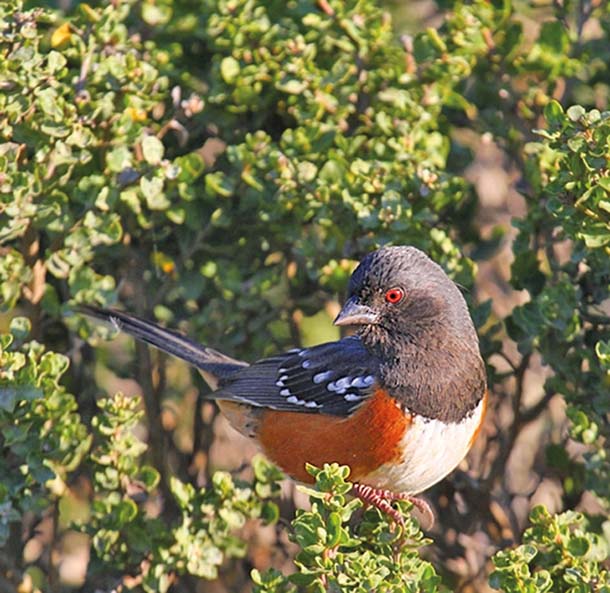
In the recent PRBO “State of the Birds Report,” coastal scrub, along with grassland, is the plant association identified as most in decline in the Seashore, with the birds that favor it also at risk. The shift from one plant community to another, and the consequent shift in bird species, make an interesting story. Gardali suggests that a somewhat different story might view that land and also the data on 67 pairs of wrentits, collected since 1979, as a cultural resource. He recalls tapes made by Dr. Luis Baptista in 1989 of the white-crowned sparrow’s local song dialect, a particular song that may never be heard again, with the disappearance of this particular coastal scrub habitat.
Our shrubland tour ends here, though many unique examples remain to be enjoyed. A multiplicity of landscape elements, such as those in the Point Reyes National Seashore, keeps the mind and heart open to complex information and to the surprise of different kinds of beauty. In a sense, diversity creates surprise; diversity is surprise. The shrublands of Point Reyes, these rich repositories of nature’s dance of call and response, are true sanctuaries of both.
“Crowning Glories” was produced in collaboration with: Point Reyes National Seashore Association (PRNSA) is the primary nonprofit partner of the National Park Service at Point Reyes. PRNSA mobilizes community support for resource preservation projects within the park and provides environmental education programs that help people explore, discover, and connect with the natural world (ptreyes.org). National Park Service/Point Reyes National Seashore manages and provides public access to 90,000 acres of national park lands on and around the Point Reyes peninsula (nps.gov/pore). Funding for “Crowning Glories” was provided by the Point Reyes National Seashore Association and the JiJi Foundation, which supports conservation, research, and science education on environmental issues in California and Baja California.

